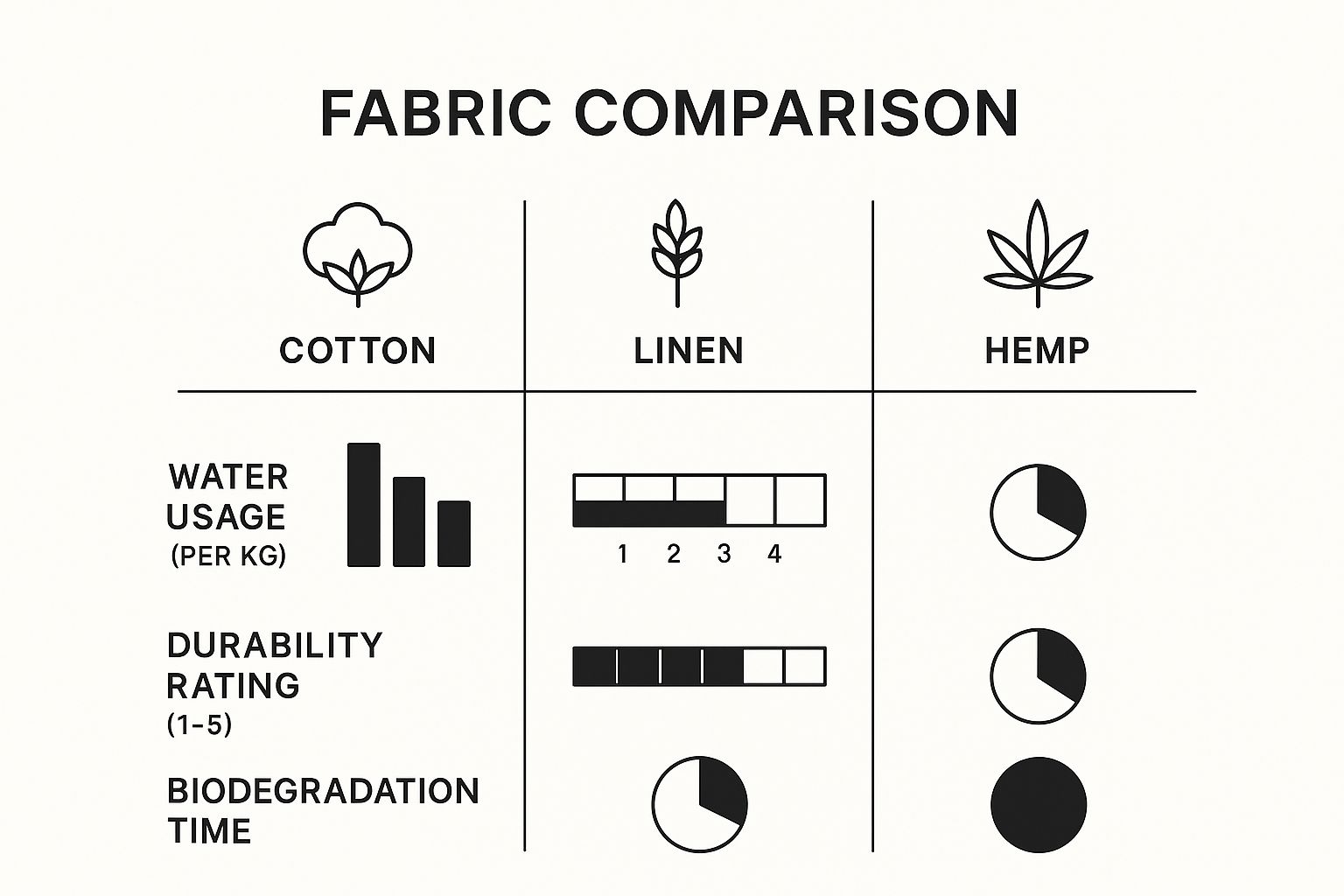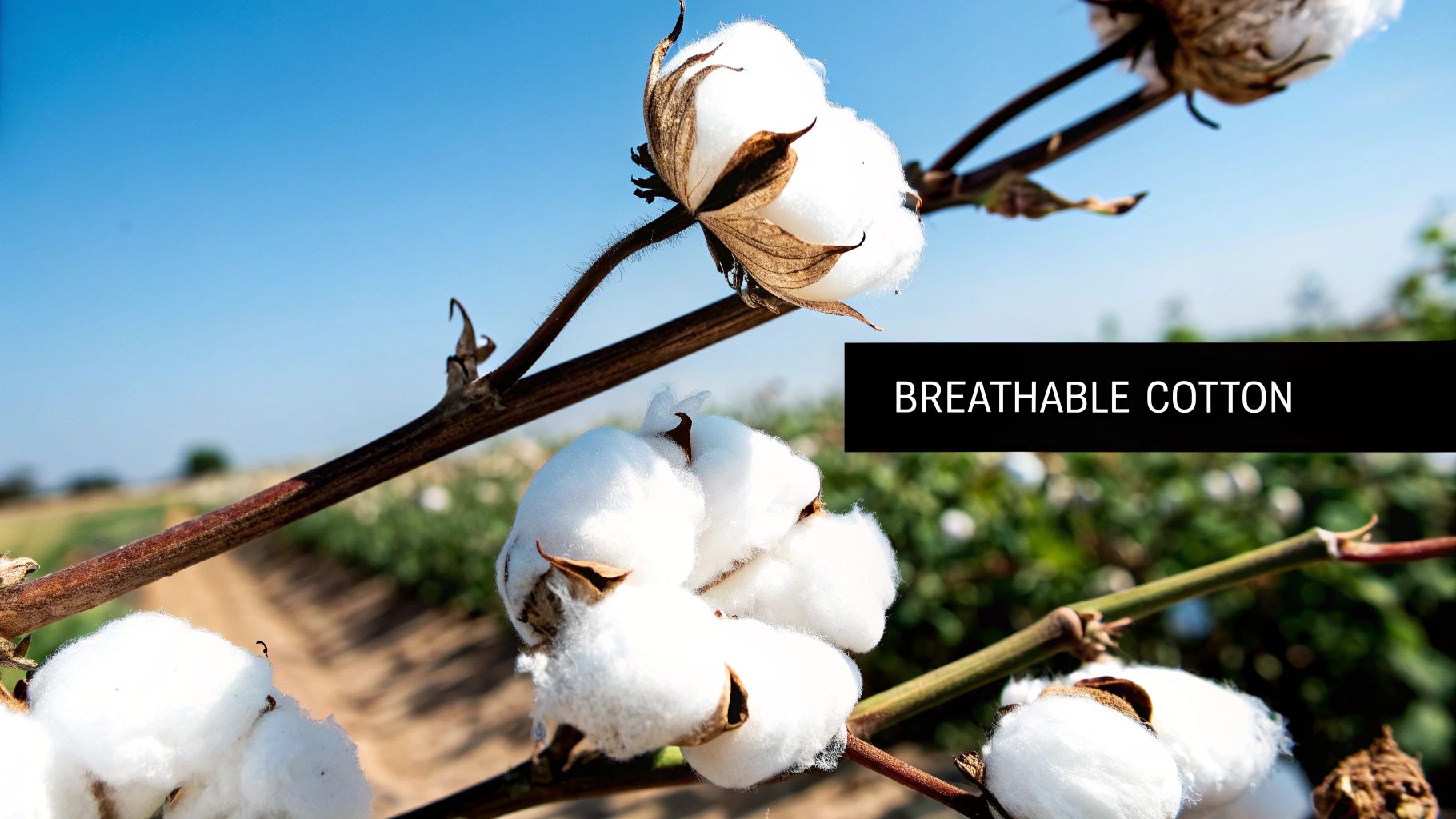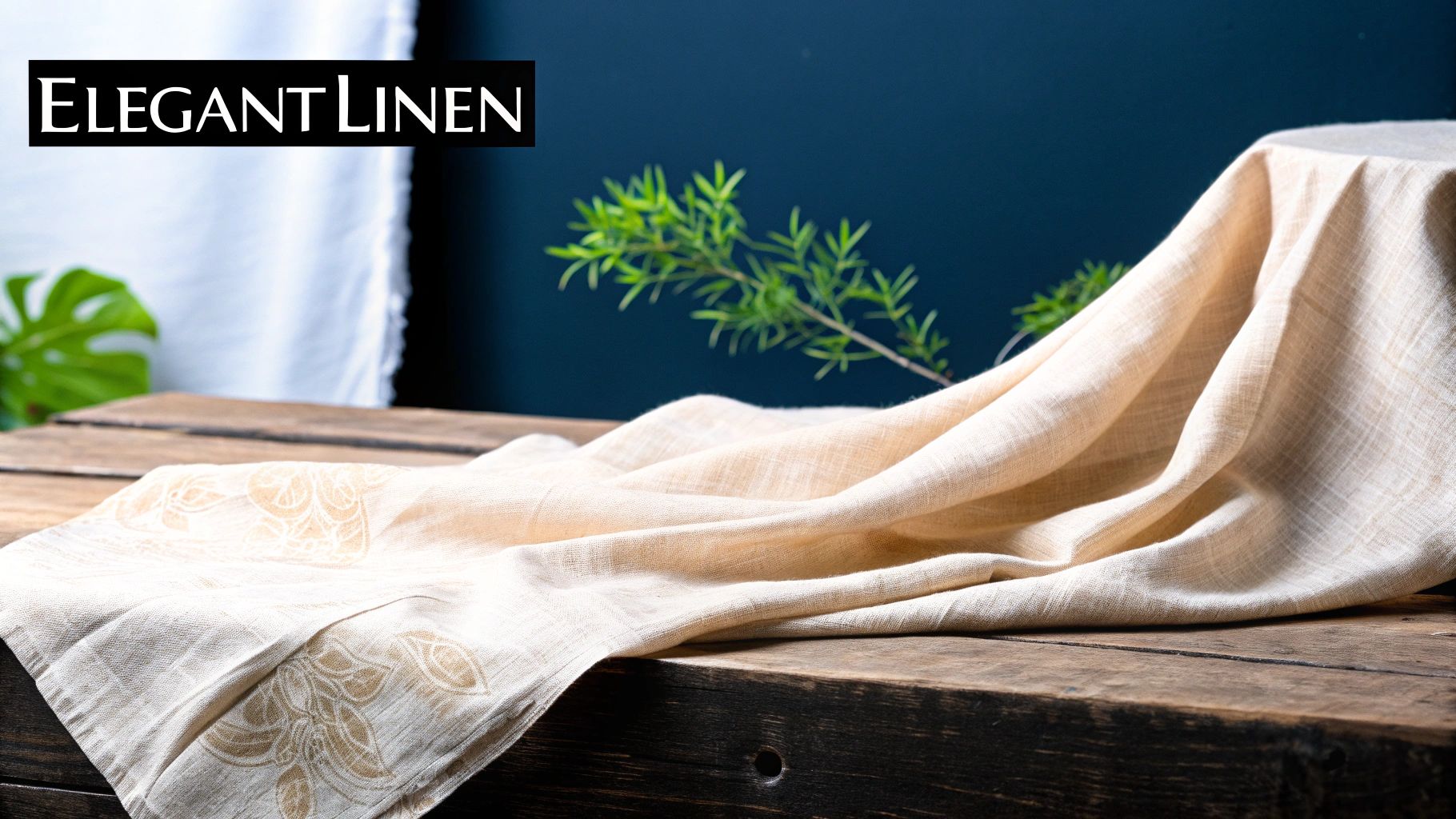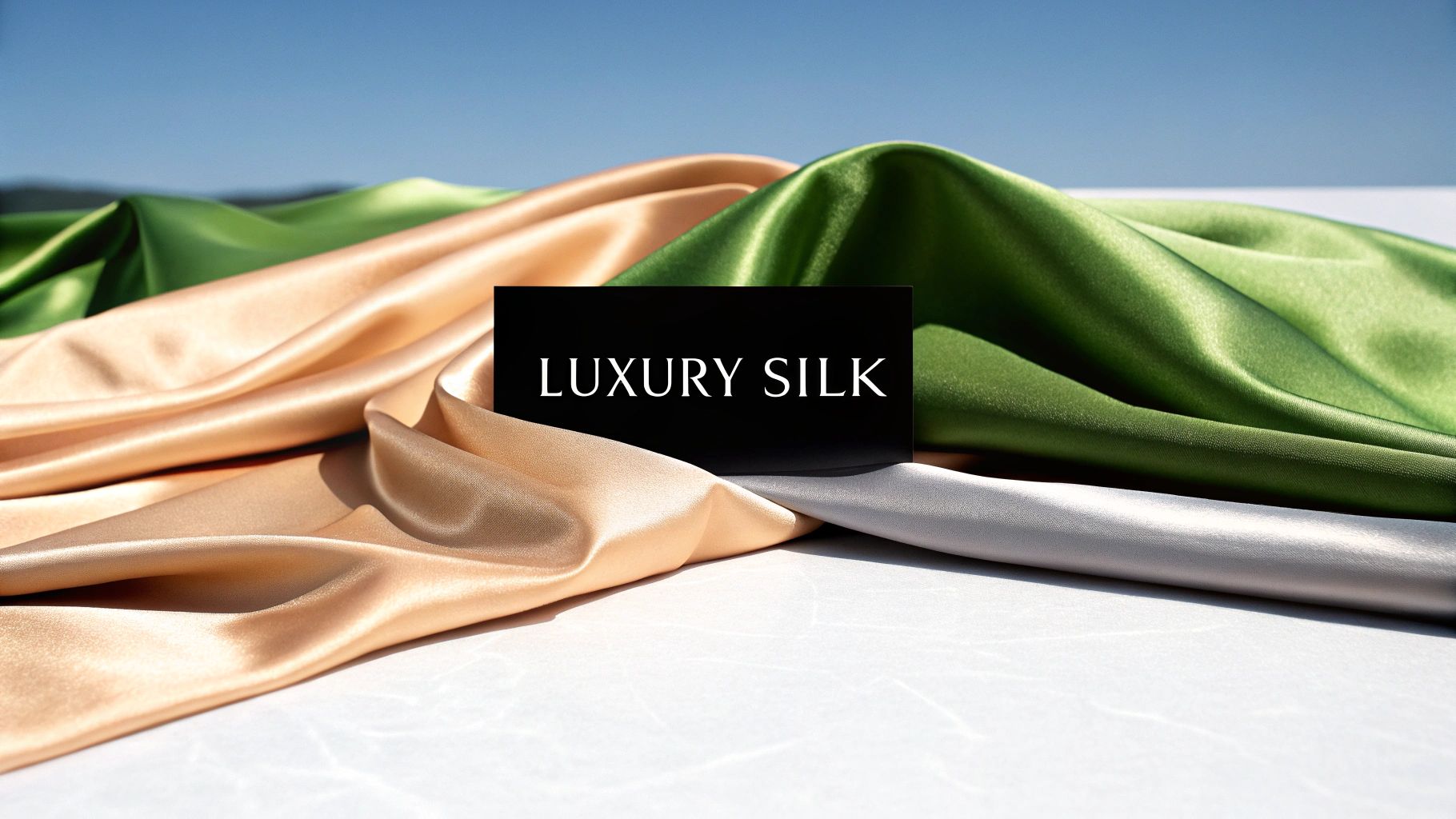Opting for clothing made from natural fabrics is a bit like choosing a meal made from fresh, whole ingredients over something heavily processed. It's a conscious decision to get back to quality, comfort, and authenticity. These textiles, which come directly from plants and animals, offer a wearing experience that's worlds apart from their lab-created synthetic cousins.
Why Choose Natural Fabrics for Your Wardrobe
More and more Kiwis are making the switch to natural fibres, and for some very good reasons. It's not just about a softer touch or a more luxurious appearance—it’s about choosing materials that genuinely work with our bodies and are kinder to the environment. Think of this guide as your map to navigating the unique worlds of both plant-based and animal-based textiles.
So, what makes these materials so special?
- Superior Breathability: Natural fibres like cotton and linen are fantastic at letting air flow freely. They wick moisture away from your skin, which is exactly what you want to stay comfortable, whether it's a hot day or you're layered up in winter.
- Hypoallergenic Properties: If you have sensitive skin, materials like silk, linen, and organic cotton can be a real game-changer. They're naturally gentle and less likely to cause irritation.
- Environmental Sustainability: This is a big one. Many natural fabrics are biodegradable, meaning they can break down and return to the earth. That’s a stark contrast to synthetics, which can sit in landfills for hundreds of years.
A Visual Comparison of Plant Fibres
To really get a feel for the practical differences, it helps to see how various plant-based fabrics stack up against each other. The image below gives you a quick snapshot of the resources and performance of three popular choices: cotton, linen, and hemp. It looks at everything from water usage to how durable they are.

As you can see, while conventional cotton is everywhere, fibres like linen and hemp give you much better durability with a far smaller water footprint. It’s a powerful reminder that our choice of fabric can be a real tool for more conscious living.
Let’s quickly break down the fundamental differences between natural and synthetic options in a table.
Natural vs. Synthetic Fabrics at a Glance
| Attribute | Natural Fabrics (e.g., Cotton, Wool) | Synthetic Fabrics (e.g., Polyester, Nylon) |
|---|---|---|
| Origin | Plants (cotton, linen) or animals (wool, silk) | Petrochemicals (fossil fuels) |
| Breathability | Generally high; allows moisture to escape | Generally low; can trap moisture and heat |
| Feel on Skin | Often soft, comfortable, and gentle | Can feel less natural; prone to static |
| Sustainability | Biodegradable, often renewable | Not biodegradable, derived from non-renewable resources |
| Care | May require specific care (e.g., cold wash, air dry) | Often easy to wash and dry; very durable |
| Cost | Can be more expensive due to production processes | Typically less expensive to produce |
This table makes it clear that while synthetics have their place (especially for durability and low-maintenance care), natural fabrics offer unparalleled benefits for comfort, skin health, and environmental impact.
From the breezy feel of a linen dress on a hot summer’s day to the dependable warmth of a merino wool jumper, natural fibres for clothes just feel right. In this guide, we’ll dive into everything from the earthy origins of plant fabrics to the resilient luxury of animal fibres, giving you the knowledge to make smart, sustainable choices that truly elevate your wardrobe and reflect your values.
The Best Plant-Based Fabrics Like Cotton and Linen
 When you think of natural fabrics, chances are your mind lands on the classics that grow right out of the earth. Plant-based textiles like cotton and linen are the undisputed cornerstones of a comfortable, timeless wardrobe. From a basic tee to a beautiful dress, these fabrics form the foundation of so many pieces we love.
When you think of natural fabrics, chances are your mind lands on the classics that grow right out of the earth. Plant-based textiles like cotton and linen are the undisputed cornerstones of a comfortable, timeless wardrobe. From a basic tee to a beautiful dress, these fabrics form the foundation of so many pieces we love.
Cotton is, without a doubt, the world’s most popular natural fibre, and for good reason. We know and love its incredible softness and versatility—it’s in our bedsheets, our favourite jeans, and everything in between. But with such popularity comes a serious conversation about its environmental footprint.
The Cotton Conundrum: Conventional vs Organic
Let's be honest: conventional cotton farming is incredibly thirsty work. To give you a bit of perspective, a single cotton t-shirt can take around 2,700 litres of water to produce. It also leans heavily on synthetic fertilisers and agrochemicals which, over time, can strip the soil of its health and vitality.
This is where organic cotton steps in as a far more sustainable hero. It’s grown the old-fashioned way, using methods that build up healthy soil and encourage biodiversity, all without the need for synthetic chemicals.
Choosing organic cotton isn’t just about the fabric; it’s a vote for a healthier planet. You're supporting a system that reduces water pollution and creates a safer environment for farmers, wildlife, and ultimately, for you.
The case for switching to organic cotton is pretty compelling when you break it down:
- Less Water: Organic farming often works with nature, relying on rainfall rather than massive irrigation systems.
- Healthier Soil: Techniques like crop rotation and composting naturally enrich the soil, so there’s no need for synthetic fertilisers.
- No Nasty Chemicals: Growing cotton without persistent pesticides and insecticides makes it safer for the people who grow it and much gentler on your skin.
If you’re curious to see how different plant-based materials stack up, it’s worth checking out a performance analysis comparing bamboo and cotton underwear.
Timeless Linen: The Effortlessly Cool Choice
While cotton gives us that familiar softness, linen offers a completely different kind of luxury—one that’s all about relaxed style and incredible durability. Made from the flax plant, linen is one of the world’s oldest textiles, long admired for its strength and uniquely beautiful texture.
Linen is an absolute superstar in the New Zealand climate. Its natural breathability and moisture-wicking ability are a lifesaver on those warm, humid summer days, keeping you cool and comfortable. It’s also one of those rare fabrics that genuinely improves with age, becoming softer and more supple with every single wash.
From an environmental standpoint, linen is a real champion. The flax plant is remarkably hardy, thriving with far less water and fewer pesticides than its conventional cotton counterpart. This low-impact process makes it a go-to for eco-conscious fashion. To truly appreciate what makes a great linen garment, it helps to understand the details, which you can read about in our guide to premium Atlas linen. When you invest in a quality linen piece, you’re not just buying for a season—you’re choosing a garment built to last for years.
Understanding Animal Fibres From Wool to Silk

Now, let's move from the fields to the flock and explore the world of animal fibres. These materials, especially wool, are deeply woven into New Zealand's identity, offering a level of performance that nature has spent millennia perfecting. Unlike plant-based textiles, animal fibres like wool and silk are protein-based, which gives them their unique resilience, incredible insulation, and beautiful lustre.
For so many Kiwis, wool is more than just a fabric—it's part of our heritage. It’s the cosy jumper we pull on during a frosty morning or the trusty hiking socks that see us through a long day on the trails. And while all wool keeps you warm, merino wool is in a class of its own. It's a true performance fibre.
The Genius of Merino Wool
You can think of merino wool as nature’s most intelligent insulator. The secret lies in its incredibly fine fibres, which have a natural crimp or wave. This structure creates thousands of tiny air pockets that trap body heat, keeping you wonderfully warm when it’s cold. But the magic doesn't stop there; these same pockets also release heat and moisture when your body temperature rises, helping you stay cool and dry.
This natural thermoregulation makes merino perfect for New Zealand's changeable climate. It's what we call an active fibre, constantly reacting to your body to keep you comfortable. It can even absorb up to 30% of its own weight in moisture before it starts to feel damp, wicking sweat away from your skin to prevent that clammy, chilled feeling.
Wool is one of the most remarkable natural fabrics for clothes. Its combination of breathability, temperature regulation, and natural odour resistance makes it far more than just a source of warmth—it’s a high-performance material perfected by nature.
NZ Wool: A Leader in Sustainable Practice
New Zealand's approach to wool is grounded in a real commitment to animal welfare and environmental stewardship. Our wool industry, supported by a flock of approximately 29 million sheep, is recognised around the globe for its ethical and sustainable farming. Renowned local designers like Maggie Marilyn proudly use this premium wool, celebrated for its strength, durability, and minimal environmental impact. This commitment to sustainable practices has truly cemented New Zealand's place in the global sustainable fashion movement.
When it's time to care for these beautiful woollen pieces, using gentle products is key to preserving the fibres. To keep them in top shape, you might want to discover the benefits of plant-derived washes for delicate garments.
The Quiet Luxury of Silk
At the other end of the animal fibre spectrum, we find silk—a material that breathes pure elegance. Produced by silkworms, silk is a continuous protein filament that is surprisingly strong despite its delicate feel. In fact, for its weight, it’s one of the most robust natural fibres there is.
Its perfectly smooth surface reflects light, creating a beautiful lustre that other fabrics just can't match. Silk's low density makes it feel light and incredibly comfortable against the skin, and its protein structure also makes it naturally hypoallergenic.
So, how do you choose between the two? It really comes down to what you need. Wool is your dependable companion for warmth and everyday resilience, making it perfect for outerwear, knitwear, and active layers. Silk, with its unmatched softness and sheen, is the go-to for luxurious sleepwear, elegant blouses, and special occasion pieces that need to feel exquisite against the skin.
The Real Environmental Impact of Your Wardrobe

The clothes we wear have a backstory that goes way beyond the shop floor. Every piece of clothing creates an environmental ripple, and the relentless churn of 'fast fashion' has magnified that into a tidal wave. It’s a model designed to pump out massive quantities of cheap, low-quality garments that are only meant to be worn a handful of times before being thrown out.
This throwaway culture has a very real, measurable cost right here in our backyard. Kiwis buy around 74,000 tonnes of clothing annually, and an astonishing 52,000 tonnes of that ends up buried in landfills. While fashion is a big part of our economy, there's a growing understanding that this level of waste is simply not sustainable. Thankfully, the conversation is now shifting towards circular solutions to tackle this problem head-on. If you're curious about how New Zealand is approaching textile waste, this insightful report from Mindful Fashion NZ is a great read.
From Landfill to Living Soil
Looking at these numbers isn't about feeling guilty—it’s about feeling empowered. The single most effective choice we have is to change our mindset, moving away from disposable trends and towards durable, timeless style. This is where choosing high-quality, natural fabrics for clothes becomes a powerful act.
Think of it this way. A polyester jacket is essentially a plastic garment, made from petrochemicals. When it gets thrown away, it just sits in a landfill for centuries, slowly leaching chemicals into the ground. It’s completely outside of nature’s own recycling system.
Now, picture a pure wool sweater. After a long and useful life, it can biodegrade. It returns to the earth, enriching the soil as it decomposes and becoming part of a natural, circular process.
Choosing biodegradable natural fibres isn't just an environmental decision—it's a commitment to a circular economy. It’s a way of ensuring that what we take from nature can one day return to it, protecting our planet for future generations.
This idea of circularity goes beyond just our clothes. When you think about the wider impact of your style choices, looking into accessories made from sustainable plant fibres offers a brilliant alternative to synthetics. For instance, you can find beautiful and sturdy eco-friendly jute sling bags that perfectly fit a more mindful approach to fashion.
By deliberately choosing natural fabrics, you're doing more than just buying a piece of clothing. You’re supporting farming practices that work with the land, cutting down on the synthetic waste choking our landfills, and investing in pieces designed to last. It's a simple yet profound shift that helps build a more sustainable future, one beautiful garment at a time.
How to Care for Your Natural Fabric Clothes
Choosing high-quality natural fabrics is a great start, but the real secret to making them last a lifetime is proper care. It’s what turns a beautiful new garment into a beloved old friend. The good news is that looking after natural fabrics for clothes isn't complicated. It’s really just about gentle techniques that respect the nature of the fibre.
Your washing machine's temperature dial is probably your most important tool here. A cold wash, around 30°C or even cooler, is almost always the right move for cotton, linen, and wool. It does a fantastic job of preventing shrinkage, uses far less energy, and is so much kinder to the fibres. Save the hot water for things that really need it, like grimy work gear or towels.
This simple act of using less hot water has a ripple effect beyond your wardrobe. It’s a small, easy way to cut down your household's energy use and aligns with bigger picture sustainability efforts, like the work done by https://www.thefoxesden.co.nz/blogs/the-foxes-den-blog/115593924-good-water-projects-by-stop-the-water.
Washing and Drying Specifics
While "wash cold" is a great rule of thumb, each fabric has its own personality. Getting to know these little quirks is the key to keeping your clothes looking their best year after year.
-
Cotton and Linen: These plant-based workhorses are pretty tough. You can pop them in the machine on a gentle, cold cycle. The main thing to watch for, especially with linen, is creasing—so don't cram the machine too full and get them out as soon as the cycle ends.
-
Wool: Wool is amazing. It's naturally antibacterial, so it rarely needs a full wash. When it does, a gentle hand wash or a dedicated wool cycle with a proper wool-friendly detergent is the way to go. Whatever you do, don't wring it out! Just gently roll it in a clean towel to squeeze out the extra water.
-
Silk: Silk is the most delicate of the lot, so it needs a bit of pampering. Hand washing in cool water with a very mild, pH-neutral soap is the safest bet. For a pro tip, add a few drops of white vinegar to the final rinse water to help bring back its gorgeous shine.
The golden rule for drying is to avoid high heat at all costs. The electric dryer is the natural enemy of most natural fibres, causing them to shrink, twist, and weaken over time. Nothing beats line drying in the shade.
Storing Your Garments Correctly
How you put your clothes away is just as important as how you wash them. The wrong storage can lead to stretched necklines, weird shoulder bumps, and even damage from pesky moths.
For anything knitted, like your cosy wool jumpers, always fold them neatly. Store them flat in a drawer or on a shelf. Hanging a heavy knit will cause its own weight to pull it out of shape over time. If you want a deep dive into this, you can learn more about how to properly wash your knitwear.
Woven pieces like cotton shirts, linen trousers, and dresses, however, do much better on hangers. Use good quality wooden hangers to prevent deep creases and allow the air to circulate, keeping them fresh and ready to wear.
Your Questions About Natural Fabrics Answered
As you start filling your wardrobe with beautiful, sustainable pieces, a few questions will naturally come up. That’s a great sign—it means you’re becoming a more thoughtful and informed shopper. This section is here to give you clear, simple answers to some of the most common queries we hear about choosing and living with natural fabrics for clothes.
Think of this as a final run-through, giving you that last bit of confidence to fully embrace this more conscious and genuinely luxurious way of dressing. We’ll cover everything from what those little labels mean to handling common wear-and-tear.
What Do Certifications Like GOTS or Fair Trade Actually Mean?
It's one thing to see a certification on a label, but it’s another to know what it truly stands for. These aren't just marketing buzzwords; they’re your guarantee that a product meets incredibly high standards that cover much more than just the fabric itself.
-
GOTS (Global Organic Textile Standard): This is the top-tier certification for organic fibres. If you spot a GOTS label, it means the fabric is made from a minimum of 70% certified organic natural fibres. But it goes deeper, ensuring every single step—from harvesting and processing to manufacturing—meets strict environmental and social criteria.
-
Fair Trade: This certification is all about the people. It’s a promise that the farmers and workers who created your garment earned fair wages, worked in safe conditions, and are supported in their communities. It's a powerful way to vote with your wallet for ethical production.
These labels are like trusted guides, helping you quickly identify clothes that genuinely align with your values for a healthier planet and a fairer world.
Are Natural Fabrics More Expensive?
At first glance, a quality linen shirt or a beautiful merino jumper often has a higher price tag than its fast-fashion equivalent. There's a good reason for that. The price reflects the true cost behind the garment—from sustainable farming and fair wages for workers to the incredible quality of the fibres themselves.
The best way to think about it is in terms of cost-per-wear. That cheap synthetic top might only survive a few washes before it starts pilling, fading, or losing its shape. A well-made garment from natural fibres, on the other hand, is an investment. It’s designed to be worn, loved, and enjoyed for years, maybe even decades.
The true value of natural fabrics is in their longevity. You end up buying fewer, better things that bring you joy for much longer, which is often more economical—and always more sustainable—in the long run.
How Do I Deal With Pilling on Wool or Shrinking?
As we've covered, proper care is your first line of defence. But a little bit of wear is a normal part of life, and gentle handling is always the answer. Pilling on wool, for instance, isn't a sign of poor quality; it's just the result of friction causing short fibres to tangle. It’s easily sorted with a fabric comb or a depiller.
When it comes to shrinking, there are almost always two culprits: heat and agitation. By sticking to cold water for washing and keeping your treasured pieces far away from the tumble dryer, you can prevent most shrinkage before it even has a chance to start. Just treat your natural fabrics with the same gentle care you’d give any of your most cherished belongings.
At The Foxes Den, we believe that true luxury is found in the quality of the materials you choose to live with every day. Our curated collections of linen homewares and clothing are crafted to bring timeless elegance and sustainable comfort into your life. Discover pieces designed to last a lifetime at https://www.thefoxesden.co.nz.


